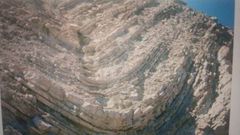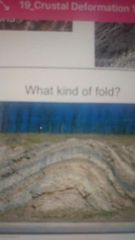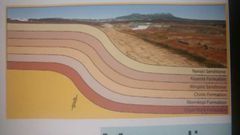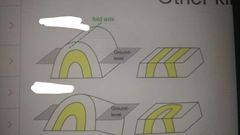![]()
![]()
![]()
Use LEFT and RIGHT arrow keys to navigate between flashcards;
Use UP and DOWN arrow keys to flip the card;
H to show hint;
A reads text to speech;
28 Cards in this Set
- Front
- Back
|
Stress definition |
Force is applied to area |
|
|
Strain |
Resulting change is shape, orientation,or location |
|
|
Types of deformation |
Elastic, brittle, and ductile |
|
|
Ductile deformation structures and level of confining pressure |
Foliations and folds High pressure |
|

What kind of fold is this? |
Syncline |
|

|
Anticline |
|

What type of fold? |
Monocline |
|

Identify |
Non plunging vs plunging |
|
|
Brittle deformation structures and confining pressure level |
Joints and faults, low pressure |
|
|
Joints |
Fractures along which no appreciable displacement has occurred although some joints have random orientation most occur in a roughly Parallel Group |
|
|
Faults |
The former brittle deformation leads fracturing and displacement of Earth's crust, break in rock |
|
|
Fault scarp |
A cliff created by movement along a fault. It represents the exposed surface of the fault prior to modification by weathering or erosion |
|
|
Reverse fault |
hanging wall moves up result of compression |
|
|
Yeah strike slip fault |
A fault along Which movement occurs horizontally, not up and down |
|
|
Footwall block |
The rock surface below a fault |
|
|
Hanging wall block |
The rock surface immediately above a fault |
|
|
Three types of differential stress |
Compressional tensional and shear |
|
|
Compressional stress |
Differential stress that squeezes a rock mass as if it's placed in a vise, associated with convergent plate boundaries |
|
|
Tensional stress |
Differential stress that pulls apart or elongates Rock bodies |
|
|
Strain |
An irreversible change in the shape and size of a rock body caused by stress |
|
|
Shear stress |
Differential stress that causes the rock to Shear which involves the movement of one part of Iraq passed another causes large segments of crust to slip horizontally past each other |
|
|
How is brittle deformation different from ductile deformation |
Brittle brakes ductile bends |
|
|
Deformation |
General term for the processes of folding faulting shearing compression or extension of rocks as a result of various Natural Forces |
|
|
Four factors that affect Rock strength and how they deform |
Temperature, confining pressure, rock type, time |
|
|
Normal fault |
When hanging wall drops down, forces pulling side apart |
|
|
How is a reverse fault different from a thrust fault |
A thrust fault is a low-angle reverse fault |
|
|
How do you figure out if a strike slip fault is Right lateral or left lateral |
By what block is coming towards you if the left block is like coming towards you it's love lateral if vice versa |
|
|
What kind of plate tectonic setting might you find strike slip fault |
Transform boundaries |

